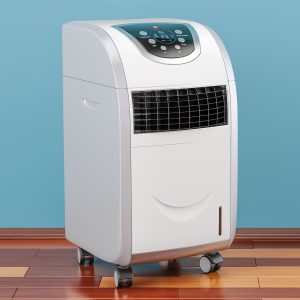
How a Portable Air Conditioner Cools a Room

How a Portable Air Conditioner Cools a Room
A portable air conditioner cools a room without blocking a window. They’re easy to move between rooms and take up very little floor space.
Portable air conditioners use a compressor to compress refrigerant gas and convert it to vapor. The vapor passes through an evaporator coil and is turned into cool air before it is blown out by the fan.
Portable
While there are different types of portable ACs, the basic way they cool a room is similar to how window air conditioners work. The air is pushed over coils that are filled with a refrigerant that absorbs heat and humidity from the room air. This air then flows through a tube that vents the heat outside.
Portable air conditioners also remove the moisture from the air and drain it via a hose or collection reservoir. There are also units that are fully self evaporative, which eliminates the need for drainage or condensation.
The main components of a portable air conditioner are the compressor, condenser coils and evaporator coils. The compressor compresses the refrigerant Portable Air Conditioner fluid to change it from a liquid to a gas, and then rapidly expands it. This creates a cooling effect and changes the liquid back to a gas. Then, the cooled air is vented out of the window.
Many people prefer to use a portable air conditioner because it does not require any sort of window installation or alteration, and can easily be moved from room to room. It is a good alternative for those who have difficulty opening or closing a window, or who live in a home or apartment that has restrictions against window-mount ACs. It can also be useful for those who have a central AC but want to cool the bedroom at night and the living room during the day.
Easy to Move
A portable air conditioner is a great alternative to window units for those who are concerned about neighborhood restrictions on windows. They also offer more flexibility to cool different rooms in the home. Many models come with wheels that make it easy to move them from room to room. If you are worried about lugging around a heavy unit, consider a model with a built-in remote control that allows you to operate the AC from a distance. Some units integrate with smart-home systems and allow you to use voice commands to adjust the settings. Night-lights can be a handy feature if you walk around a lot at night and want to avoid kicking the air conditioner.
It is important to remember that a portable air conditioner does not vent through the window but instead vents through an exhaust hose that runs outside. This means that you must be careful when moving your PAC around as you must be sure that the hose is unobstructed and there are no leaks. It is also recommended that you regularly lubricate your portable air conditioner to prevent friction between components and reduce the likelihood of wear.
Many people ask if you can lay a portable air conditioner on its side, but this is not possible because of the need for venting through the exhaust hose. It is also not recommended because it could damage the compressor and it would be difficult to collect humidity from the air and eliminate it.
Energy Efficient
The main function of any air conditioner is to pull in the room’s air, condition it by extracting heat and then releasing the conditioned air. Portable ACs use fans to circulate the air through the cooling process. They also use a compressor to raise the temperature of the refrigerant used for cooling, an evaporator coil to cool down the air, and a condenser to remove water through condensation. The unit then transfers the collected moisture outside through a hose, or sometimes a bucket that has to be drained periodically.
A new portable air conditioning unit with a higher energy efficiency rating may cost more, but it will save you money on your electricity bill over the long run. The ENERGY STAR website has a list of the most efficient portable ACs, and many models are certified as such.
Aside from deciding which model to buy, you can further reduce your energy consumption by keeping the portable AC on only for rooms that are being occupied. Leaving the unit on all day uses a lot of power. You can also pair the device with a smart air conditioner controller like Cielo Breez to set schedules and location-based triggers. You can also track usage reports on the app to make sure you aren’t using it more than necessary. Lastly, remember to avoid running other high-energy devices while the PAC is on.
Low Maintenance
As the name suggests, a portable air conditioner combines all the necessary features of an AC into one standalone appliance. Compare that to a central or even ductless air conditioner which needs an indoor evaporator installed in the room, a compressor outdoors and a venting system for releasing the exhaust.
Most portable air conditioners use a fan to blow hot, stale and humid air over a cold metal coil where it comes into contact with refrigerant gas at a much lower temperature. As the air cools, moisture vapor in it condenses on the cold coil surface and drips off into a pan that can be easily dumped.
Some models may also have a drain port where you can connect a hose and direct the collected water to a drain or elsewhere in the home. Fully self-evaporative portable air Portable Air Conditioner conditioners, like the Hisense model reviewed here, are available that don’t require you to deal with the collection pan or dumping.
Programmable settings allow you to choose from a range of operating modes and temperatures, while a sleep mode can shut the unit off after a specified amount of time. Smart models integrate with smart-home systems like Alexa to enable voice commands and automatic operation based on your schedule. A quiet option reduces noise levels to below ambient noise, which is ideal if you want to sleep while the appliance operates.

